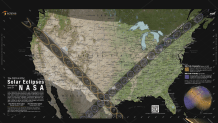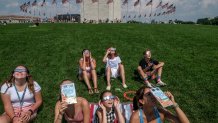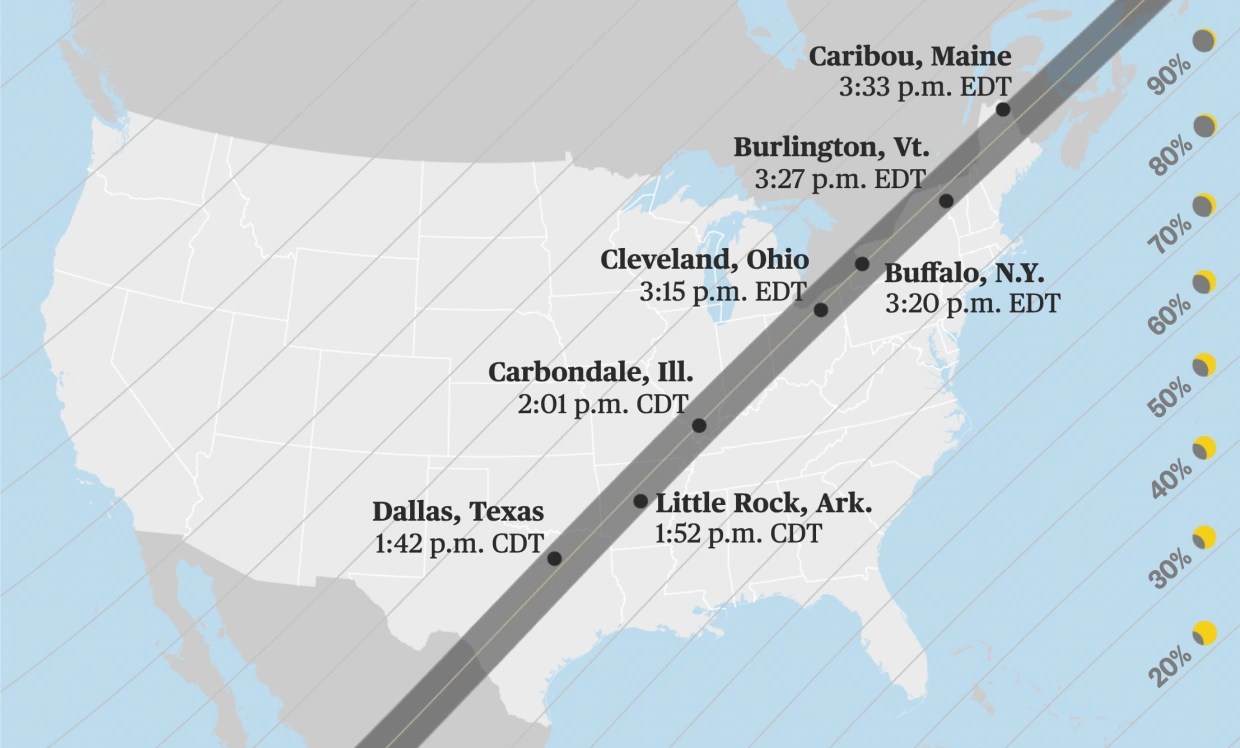Watch live coverage of the Great American Eclipse above.
Thousands of people in the Washington, D.C., area stepped outside Monday for a glimpse of a last-in-a-generation solar eclipse.
The total solar eclipse moving across the United States will be the last one visible over the continental U.S. for another 20 years. While D.C., Maryland and Virginia aren't in the path of totality, the moon blocked out nearly 90% of the sun at the moment of totality, about 3:20 p.m.
Since D.C. wasn't in the path of totality, people needed eclipse glasses to safely view the sun at any point.
We're making it easier for you to find stories that matter with our new newsletter — The 4Front. Sign up here and get news that is important for you to your inbox.
Still, a crowd that could rival the Fourth of July throng gathered on the National Mall. When the solar eclipse hit its maximum over D.C., and only a crescent-moon-shaped sliver of the sun was visible through eclipse glasses, the crowd erupted into cheers.
As the paths of the sun and moon partially aligned around D.C. beginning shortly after 2 p.m. the sky grew slightly darker, like when sunset approaches in the dead of winter. Crescent-shaped shadows formed underneath trees.
"We did notice the temperatures drop by a good 5 degrees here," Storm Team4 Meteorologist Amelia Draper said.
A smattering of clouds in the sky didn't stop D.C. from enjoying the view.
During the eclipse, the moon casts its shadow on parts of North America as it comes between Earth and the sun, said Gina DiBraccio, the deputy director of heliophysics at NASA's Goddard Space Flight Center.
"If you have the opportunity to view this, whether it's the total eclipse or a partial eclipse in the D.C. area, you should absolutely do it because it's just a special kind of lifetime event," DiBraccio said.
Residents from across the D.C. area and beyond were staking spots on the grass on the National Mall hours before the eclipse began. Tents representing various Smithsonian museums were handing out eclipse glasses and sharing information on the scientific and cultural importance of the eclipse.
You wouldn't have known it was a Monday from the size and enthusiasm of the crowds. It feels more like a busy Saturday — people were seen walking dogs, biking and setting up picnics with friends and family.
From the National Mall to the NASA Goddard Visitor Center, eclipse viewers are partaking in a human tradition that predates written history -- although records of eclipses stretch back thousands of years.
According to a NASA article, petroglyphs found in County Meath, Ireland, may be our earliest records of an eclipse; they date back to 3340 B.C.E. Scribes in Anyang, China, wrote on shells and bones that "the sun has been eaten" around 1200 B.C.E. Much later, the 1918 eclipse helped confirm Albert Einstein's theory of relativity, rocketing the physicist to fame, according to the National Park Service.
Read below to learn when the solar eclipse is and where to see it around D.C.
What time was the eclipse in the D.C. area?
The solar eclipse on Monday was seen in the D.C. area from 2 p.m. to 4:30 p.m. Maximum eclipse happened about 3:20 p.m., but the exact timing depended on location.
The moon will begin to move in front of the sun about 2 p.m., slowly covering more of the sun until about 3:20 p.m. It will then move off the sun until about 4:30 p.m., according to the Northern Virginia Astronomy Club (NOVAC).
What's the path of the eclipse?
Parts of Mexico saw the eclipse first. The path of totality in the U.S. stretches across 13 states from Texas to Maine.

Some people are expected to witness the eclipse from special flights. Businesses around the country are planning to offer special deals and creative souvenirs, such as eclipse-themed beer.
Is the DC area in the path of totality?
No, the D.C. area will not see a total solar eclipse. The moon covered about 90% of the sun’s width in the D.C. area during the solar eclipse, according to NOVAC.
In Greenbelt, Maryland, the moon blocked about 86% of the sun’s light, NASA’s Goddard Visitor Center said. It was said to obscure 87% of the sun at its maximum in College Park, according to the University of Maryland's Department of Astronomy.
In Rosslyn, Virginia, the moon blocked about 75% of the sun, the Rosslyn BID said.
A map depicts solar obscuration by area during the 2024 solar eclipse.
What to know about eclipse glasses
Take it from former president Donald Trump! Be sure to protect your eyes from the sun during the phases of a solar eclipse.
For safe viewing, NASA recommends the use of eclipse glasses or handheld solar viewers. It's important to note that regular sunglasses are not dark enough to safely filter the bright light.
Eclipses can be briefly viewed without protection when the moon completely blocks the sun. However, since D.C. isn’t in the path of totality it is recommended to wear eye protection the entirety of the eclipse.
Here's where to find solar eclipse glasses in D.C., Maryland and Virginia.
For more safety information, visit NASA's website.
When is the next solar eclipse after 2024?
Total solar eclipses are rarely visible throughout a huge swath of the United States.
The next total solar eclipse to sweep across the continental United States is set to occur on August 12, 2045, following a path from northern California to Florida, according to NASA (although Alaska will see one in 2033, and a total eclipse will pop over Montana and North Dakota in 2044, Forbes reports).
Solar eclipse events in the DC area
It's totally (totality?!) OK to take an afternoon break from work to enjoy the sky. If you do, take a look at the list below.
If you want to experience the solar eclipse from your backyard, check out these kid-friendly solar eclipse activities from the National Air and Space Museum.
DC partial solar eclipse events
Solar Eclipse Festival on the National Mall
📅 April 8, noon to 4 p.m.
📍 National Mall, D.C. between 4th and 12th streets
🔗 Details
Eclipse 2024 Watch Party
📅 April 8, 1 to 4 p.m.
📍 MLK Library’s Garden Rooftop; 901 G St NW, Washington, D.C.
🔗 Details
Solar Eclipse Party @ Hedy's Rooftop
📅 April 8, 2 to 6 p.m.
📍 Hotel Zena; 1155 14th St. NW, Washington, D.C.
🔗 Details
Solar Eclipse Viewing Party at Deck 11 Rooftop
📅 April 8, 2 to 4:30 p.m.
📍 YOTEL; 415 New Jersey Ave. NW, Washington, D.C.
🔗 Details
Solar Eclipse Viewing Party at Tag Rooftop Bar
📅 April 8, 1 to 4 p.m.
📍 The Ven at Embassy Row; 2015 Massachusetts Ave. NW, Washington, DC
🔗 Details
Maryland partial solar eclipse events
Partial Solar Eclipse Event at the Visitor Center
📅 April 8, noon to 4 p.m.
📍 NASA Goddard Visitor Center; 9432 Greenbelt Road, Greenbelt, MD
🔗 Details
Skywatching: Partial Solar Eclipse
📅 April 8, 2 to 4:30 p.m.
📍 Observatory Park; 100 Desellum Ave., Gaithersburg, MD
🔗Details
Solar Eclipse at College Park
📅 April 8, 1:30 to 4:30 p.m.
📍 University of Maryland; grassy area in front of Martin Hall, College Park, MD
🔗Details
Solar Eclipse Watch Party
📅 April 8, 10 a.m. to 4:30 p.m.
📍 Maryland Science Center; 601 Light St., Baltimore, MD
🔗Details
Virginia partial solar eclipse events
Solar Eclipse Viewing
📅 April 8, 2 to 4 p.m.
📍 Gateway Park; 1300 Langston Blvd, Rosslyn, VA
🔗 Details
Solar Eclipse at Sky Meadows
📅 April 8, 1 to 4:30 p.m.
📍 Sky Meadows State Park, 11012 Edmonds Lane, Delaplane, VA
🔗 Details
Eclipse Where Sun, Moon and Wonder Align
📅 April 8, 1:30 to 4:30 p.m.
📍 Sweet Run State Park, 11661 Harpers Ferry Road, Hillsboro, VA
🔗 Details
Partial Solar Eclipse Celebration Monday
📅 April 8, 2 to 4 p.m.
📍 Fairfax County Parks; Ellanor C. Lawrence Park; Burke Lake Park, VA
🔗 Details
Safely See the Partial Eclipse
📅 April 8, 1:30 to 4:30 p.m.
📍 Fairfax County Parks; Historic Huntley; Turner Farm Park, VA
🔗 Details
View the Total Solar Eclipse!
📅 April 8, 3 to 4 p.m.
📍 Sherwood Regional Library; 2501 Sherwood Hall Lane, Alexandria, VA
🔗 Details
Solar Eclipse Party!
📅 April 8, 1 to 4 p.m.
📍 Centreville Regional Library; 14200 Saint Germain Drive, Centreville, VA
🔗 Details
Partial Solar Eclipse Event
📅 April 8, 11 a.m. to 3 p.m.
📍 George Mason University Observatory; Research Hall, 10401 York River Road, Fairfax, VA
🔗 Details
Solar Eclipse - Watch Party
📅 April 8, 2 to 4 p.m.
📍 Settle Down Easy Brewing Co.; 2822 Fallfax Drive, Falls Church, VA
🔗Details

When was the last total solar eclipse? Let's rewind to 2017
In August 2017, a total solar eclipse moved across the U.S. from the West Coast to the East Coast for the first time in 99 years.
It crossed in a narrow path over 14 states between Lincoln Beach, Oregon, and Charleston, South Carolina, NASA wrote on its 2017 Total Solar Eclipse page.
The D.C. area experienced a partial solar eclipse with the sun blocked from 79 to 90%, WTOP reported in 2017.
Photos from the eclipse show eyes glued to the sky in downtown D.C. and on the National Mall, with shorts-clad tourists and business casual workers donning solar eclipse glasses or using specially made viewing tools.
The moon is relatively close to Earth right now, meaning Monday’s eclipse will have a longer period of totality than the 2017 eclipse did, the National Air and Space Museum’s Dr. Teasel Muir-Harmony said.
“Solar eclipses in general are quite special,” Muir-Harmony said. “This particular one, the sun is at its solar maximum. So, it’s very, very active right now. The one in 2017, it was actually at its solar minimum. So, there could be interesting things to see.”
Solar maximum means eclipse viewers may be more likely to see special streams of light and prominences, “which appear as bright, pink curls or loops coming off the Sun,” according to NASA.
Want to know what's up for your weekend? Sign up for The Weekend Scene, our newsletter about events, experiences and adventures for you and for your family around the DMV.



